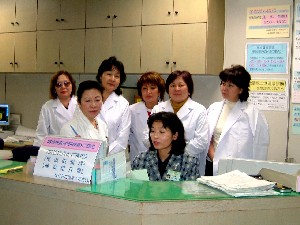Over the Years
Home > Over the Years > Over the Fiscal Years (2000 APR - 2010 MAR) > Visit by JICA Kazakhstan Health Administration Observation Team
Visit by JICA Kazakhstan Health Administration Observation Team
Visiting team members:
Leader | Kussainova Aigul | Deputy Director-General of the Bureau of Health Care for the East Kazakhstan Provincial Government |
| Member | Sagandykova Sagadat | Director of the Medical Comprehensive Consultation Department of the National Medical Diagnostic Center, JICA Coordinator |
| Member | Kadyrova Englik | Vice President of National Medical Research Center |
| Member | Zhuasbaeva Galia | Nursing Science Chief Specialist of the Bureau of Health Care for Semipalatinsk City Nursing Association |
| Member | Shayahmetova Guldjan | President of the National Semipalatinsk College of Nursing |
Period:
Purpose:
- Inspecting the Japanese health care administration system
- Learning about the examination, treatment, and computer database used for radiation-exposed care
- To study comprehensively the science of nursing, as well as learn new ways to enrich the quality of health care
Toured facilities:
Hiroshima Prefectural Government
Hiroshima City Government
Hiroshima University Research Institute for Radiation Biology and Medicine
Radiation Effects Research Foundation
Hiroshima A-bomb Casualty Council
Hiroshima Red Cross and Atomic-bomb Survivors Hospital
Hiroshima A-bomb Survivors Nursing Home ; “Kandayama Yasuragi-en”

Visiting Scene (Hiroshima A-bomb Casualty Council)
Member’s Impressions:
In our country, the Republic of Kazakhstan, the National Government has addressed the following legal remedies for patients suffering from radiation exposure as a result of nuclear tests in the Semipalatinsk region.
1) The enactment in 1992 of the Support Law for those exposed to radiation suffering from the nuclear tests in Semipalatinsk region.
2) Resolution of the 336 District Committee, which enabled the Government to provide radiation exposed patients with medical care services.
3) The revision of Section 240 of the Health Care Ministry Law
In accordance with the above proceedings, the following has also taken place:
1) The definition of “radiation-exposed patients” as it applies to the nuclear tests.
2) The designation of the radiation exposed area as calculated by distance from the site and radiation dosimetry.
3) The payment of medical care allowances to the (as noted above) designated radiation-exposed patients.
4) The definition of second-generation radiation exposed patients; as defined presently, those born by radiation-exposed mothers up to 1992.
5) Radiation-exposed patients are entitled to receive free health examination and treatment on the grounds of the Resolution of the 336 District Committee.
6) Radiation-exposed patients are provided with certificates designating disease, injury, or death resulting from radiation exposure. These certification are provided by the Evaluations Committee established in each district.
7) Employees defined as radiation-exposed patients are provided 10 additional paid holidays by the government.
8) The designated radiation-exposed patients are provided with disability pension, 4,000 Tenge or about 31 US$ in addition to general pension by the 336 District Committee,. Spouses are also entitled to receive the above pension after the radiation-exposed patients die.
The Japanese government has carried out several projects in the Semipalatinsk region over the past 5 years. Not only has the bridge over the Irtish River been newly constructed, but also a number of other projects are underway care of numerous Japanese NPO’s.
Provided via the Japan International Cooperation Agency (JICA), we would like to focus on how very helpful Japan’s support has been. JICA projects have greatly contributed to the improvement of health care services and the early detection of cancer in the Semipalatinsk region. Thanks to JICA projects, large-scale medical organizations are now provided with medical equipment in collaboration with the Ministry of Health care of Kazakhstan; technical training in various medical fields is being done in Japan, or in the Kazakhstan cities of Astana or Ust-Kamenogorsk. Training includes use of mobile examination vehicles, improvement of radiation treatment, utilization of computer databases, “Papanicolaou Staining” or the cytological diagnosis method, and health examinations for residents close to the radiation exposed region.
We hope that this relationship with Kazakhstan will be maintained with the assistance of HICARE, Hiroshima University, NASHIM, Nagasaki University, and the Oita University of Nursing and Health Sciences.
We would like to extend our deepest appreciation to the Japanese government, Japanese people, and Japanese experts regarding health care for the radiation-exposed. We wish nothing but prosperity for the country of Japan and its warm-hearted and intelligent people.




